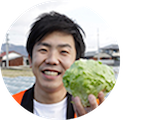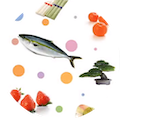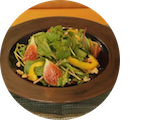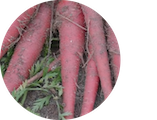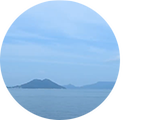
In autumn of appetite, Sanuki Road is full of delicious things. Matsutake udon, chestnut rice, feast of the autumn festival with rice cakes and rice cakes. Harvesting of persimmons, mandarin oranges, olives, and kiwis in late fall also begins. Udon and Udon noodles are also delicious season. It is Kanonji city on the western edge of Kagawa that visits Sanuki Road in autumn.
The westernmost part of Kagawa Prefecture, don't have money! ?
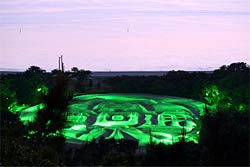
Kanonji is a central city in the western part of Kagawa prefecture, located in the southern part of Shikoku, facing the Hiuchi Nada in the Seto Inland Sea. It became Shin Kannonji City due to the merger of Heisei, but this time we will visit the old Kanonji City area to visit delicious things and footprints of history.
Kannonji City's great landmark is Kanei Tsuho's "sengata". This sand painting has also become the title back of the former TV show "Heiji Heisen". The size is 122m east-west, 90m north-south, 345m around. Huge money is made in Ariakehama. According to legend, residents digged up overnight in 10 to embark on a patrol of the feudal lord, Takatoshi Ikoma. Now, in the spring and fall, volunteers remake their hands. This fall is also scheduled for October 1633 (Sun).
This sand painting can be seen from the summit of Mt. Kotan, and when the sun goes down, it is lit up with a talume mercury lamp. By the way, looking at this monetary form, it is said that you are not inconvenienced by money. This is another beautiful sunset spot that has been selected as one of the XNUMX Best Sunsets in Japan.
Rare one temple and two sacred grounds, modern main hall
Zenigata is located on the west side of Kotodansan, but at the foot of the eastern side of the mountain are Jinin and Kannonji. Both are the Shikoku sacred grounds. This is the only place in the XNUMX temples that has two temples on one precinct.
First, enter the precincts and on the left is Shikoku Sacred Ground No. 68 Shinkeiin. The old main hall was on a long stone staircase, but is now up the modern staircase on the left. From here, I could see a beautiful garden.
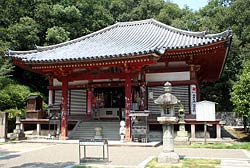
Next is the 69th temple Kannonji. The beautiful main hall is said to have been built in the early Muromachi period, and is also called the Kondo. The name of this city is derived from the name of this temple, but the beginning of the temple is the third year of Taiho (3), the priest of Jinguji (now Kanonji) enshrined Koto Hachiman Shrine, and the second year of Daido (703) Kobo Daishi It depends on the placement of the statue of Seinnon at the Jingu-ji Temple. Therefore, it was called Kannonji, and the name of this temple eventually became the name of a village, town, or city. Beside the main hall is the only resting place in the precinct, "Gotoan". You can have Shojin Udon or Amazake, and souvenirs are also available. In addition, there is free entertainment of tea.
Money Museum from Ichiyoan
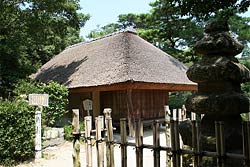
About 1528 km northwest of Kanonji / Kein-in, there is Kosho-ji Temple, where the founder of Hakai, Sozan Yamazaki, was founded in the first year of Kyoroku (22). ) There is "Ichiyoan", which I spent until October 1553 at the hermitage. It was described that the quaint and beautiful roof was covered with reeds from Lake Biwa donated by the citizens of Kusatsu, Shiga Prefecture, the birthplace of Yamazaki Sokan.
Nearby, there is also "Norigami pine" where the roots of Kuromatsu show a mysterious shape. If you go to the sea from here, you can see the Matsubara of Ariakehama, which is said to be 5 of them. There are also Kotodan Hachimangu Shrine, which is the name of the park, and a rare museum called World Coin Museum, whose theme is money after monuments at Michinoeki.
On a quiet autumn day
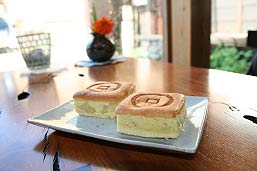
If you walk around Kannonji city, there are several shops where both Japanese and Western sweets are delicious. As a representative, we will visit “Shiraeido”, famous for the famous confectionery “Kannonji”, which designed a coin shape. Although it has a history of more than 100 years, the store is worth a look because it was designed by a Japanese paper creator and space designer, Mr. Morita (resident in Kagawa Prefecture). There is also a coffee corner, so let's spend a moment.
Recommended souvenirs include famous confections related to Kannonji, such as the famous confections Kannonji and Ichiyoan, Sengata Monaka and Sengata Senbei. A delicate and gentle taste that makes Kannonji's true heart into sweets. Shops and sweets are as peaceful as calm autumn days.
In addition to the Yanagimachi head office, there are Sakaemachi and Yoshiokacho branches near the station.
How about autumn shrimp roast?
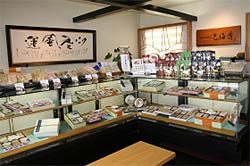
Hiuchi Nada, which spreads out in front of Kanonji City, is known for its delicious shrimp. Therefore, there are several famous Ebisenbei shops in the city, and among them, I visited Mr. Shimahide, whose name is known nationwide. Founded in 25 as Shimahide Fisheries, and started processing shrimp and other delicacies in 1950, Shimishuhide is now a famous manufacturer of shrimp crackers, as a department store and mass retailer nationwide. Products are lined up at specialty stores.
Commitment to natural ingredients, such as red shrimp and luxury prawns that are rich in flavor and can be eaten whole, Wasanbon of high quality sweets rich in minerals, naturally purified natural salt, mineral water purified with barley rice stone etc. We use carefully selected materials that have been carefully examined. This material is carefully baked with skill. It is known for its beautiful products and assortments, such as "Ebi Senbei", which has a crisp and gentle texture, "Ebi Sakiyaki", "Ebi style", and "Ebi Kaiyaki". There is also. From September 9, "Autumn Shrimp Roast" containing matsutake mushrooms. From October 28, "natto shrimp roast" that considers health will also be sold. Why don't you taste the autumn limited shrimp crackers?
Shrimp itself "Aimusaki"
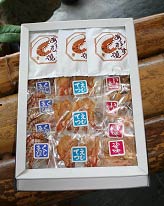
Next time, we will visit “Makuya Toyoura Shoten” where the fragrant wind is overflowing in the alley. The “Aimusuyaki” here looks the same as the shrimp, but it does not add anything to the shrimp itself. Using fresh raw shrimp (red shrimp, sal shrimp, tiger shrimp, majako, etc.) taken from Hiuchi Nada, peel the shells one by one by hand and carefully make the back. Place the raw meat on a steel plate and bake it tightly from the top. Naturally, there are no additives and no mixtures, but this has a taste that can not be said.
Mankyuya Toyoura Shoten was founded in 10. It has been 1877 years this year. It was close to the port, so it had been selling hatago and miscellaneous goods for about 130 years before the establishment of Aimusaki. Therefore, they sold small fish and shrimp kamaboko from Hichinada, but they do not last a long time, so `` Amogiyaki '' is created to steam only the shrimp body so that it will last somehow. That was. Anyway, because it is shrimp itself, it is exquisite even if you add it to mayonnaise soy sauce. Also goes well with cream cheese and can be a party canapé. In addition, you may put it in a sashimi, and it is recommended for hot pot ingredients in the coming season.
Kamaboko & Chika
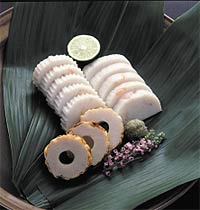
There are many stores in Kanonji that deal with kamaboko and other paste products. This time, we will visit “Nikaya”, which was also featured on a gourmet TV program.
"Nikaya" was also a location for the movie "Seishun Dendeke de Kedeke" at the time of the old townscape. When a novel by the local Naoki Prize-winning writer Sunao Ashihara was made into a film by the director Obayashi, it became "The House of Isao Okashita of Chikaya". However, it was completely renovated following the road expansion. However, that warm personality has not changed, and the fourth generation and his son greet them with a gentle smile.
What made Nikkaya famous all the time was the TV show “The New Cooking Show”. When "Cengata Chikuwa" appears in this, the storm of the telephone immediately. It seemed like a typhoon for about two weeks. This Chikuwa is really wonderful. On the TV, I wrapped a whole chicken and put it on a sanuki udon, but after all, it is a delicious dish that is eaten raw. Then, let's put it in a pot, let's make it oden, and finally the full-scale season of the kneaded product comes.
Amazake for the autumn festival
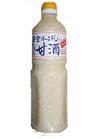
Delicious amazake is also handed down to Kanonji City. In the first year of Eiroku (1558), Amagiri Castle owner Kagawa Nokkei recognized the production and sale of privileges and privileges in the Muromoto area, and delicious amazake was made. Prince shrine in Muromotocho is known as a rare koji god in Japan. I visited the "Irie Koji Mill" in Murohonmachi. It has been said that people have been gathering around Kannon-ji Temple since ancient times, and amazake was often served and was indispensable for celebrations. Especially at the autumn festival, it was an indispensable drink, and it was customary to go to a relative's house with amazake and go to a festival guide saying "Please come because there is an autumn festival".
This "Koji Muromoto" is a handmade koji made by natural fermentation based on a yeast with a unique flavor created by the Irie Koji Mill, based on a 500-year tradition. Amazake was also said to be good on TV health programs, but amazake made with this koji is particularly rich in natural glucose, live lactic acid bacteria, oligosaccharides and various vitamins.
The Irie Koji Mill has been selling amazake in plastic bottles for 12 years due to changes in lifestyle. Amazake, which can be found at supermarkets and directly after delivery, has been loved for generations with moderate sweetness.
Embroidery the futon of God
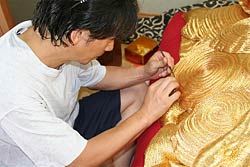
In the fall of Kannonji City, the “Chousa Festival” is exciting. At the Koto Hachimangu Shrine's autumn festival (19, October 10, 19, 20), nine giant drums will unfold. I visited a craftsman who embroidered a futon of God to decorate a gorgeous taikodai at this “Chosa Festival”. This is the fourth generation Toshiro Takagi who inherited the "gold and silver thread decoration embroidery" which has a tradition of more than 21 years in Kannonji city area. “It's a lonely task, but the example is my third generation father and grandfather. I'm still impressed when I look at my father's work in his fifties. 9 years of work. Known as a skilled craftsman. The decorative embroidery that the Takagi family has been performing for generations is still active and requests repairs. "It seems that it is fashionable to renew anything, but if you do a careful job, you can repair it as many times as you want," he said. He is repairing his work. The finished thing will be dazzling again on the fine stage of the autumn festival.
Temari is a vegetable-dyed cotton thread
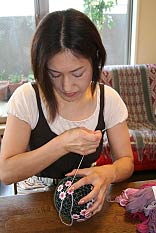
One of the traditional crafts that have been around for a long time in Kanonji and are now being spread is Sanuki Kagaritemari. In the Edo era, a hand-made ball made of cotton thread made from cotton (then salt and sugar), which was one of Sanuki Sanpaku, was a longing and luxury item for women. At that time, when only two people could make it at Kannonji, Mr. Norio Araki, who also served as the director of the folk art museum at Kuribayashi Park, established a preservation party, and his skills were preserved.
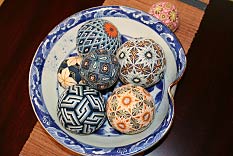
Araki started the "folk art movement" and built a folk art museum at his home in Kanonji. In addition, we continued our efforts to make over-the-counter drips with plant dyeing as in the past, and his wife and his wife, Eiko Araki, inherited that desire. Mr. Nagako, who started learning after marriage, lives in Takamatsu City, but as a traditional craftsman, he has also opened a classroom in Kanonji City. In addition to handmade kits, there are many other works that are unique to Nagako, such as fragrance balls with odor bags and mobile straps.
In the past it was a tea shop, now a udon shop
In the fall of Kannonji City, the “Chousa Festival” is exciting. At the Koto Hachimangu Shrine's autumn festival (19, October 10, 19, 20), nine giant drums will unfold. The gorgeous taikodai is adorned with the "Chosa Festival". In the old days, there was a teahouse for the pilgrim at the foot of the mountain, just halfway between Kannonji and Motoyamaji. The old road was evacuated due to the river widening work, and the last two houses that were making delicious rice cakes next to each other were relocated and opened. There are "Kazama Mochi" along National Route 21 and "Kazama Mochi Fukuda" along Prefectural Road 9 which is close to the original location.
Sanuki no Yume XNUMX specialty store
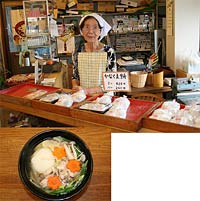
"Kazuma Mochi" along National Route 11 is a specialty store that uses wheat "Sanuki no Yume 2000" made in Kagawa Prefecture. As the name suggests, we are particular about rice cakes, and every morning we use fresh rice cakes made from 100% glutinous rice from Kagawa Prefecture. To eat freshly-made mochi and udon from Yume 2000, we recommend “Riki Udon”, which contains lots of vegetables and chicken. In the restaurant, you can find not only udon but also traditional dishes made with local seasonal vegetables and fish.
Sanuki Dream Taste Collaboration
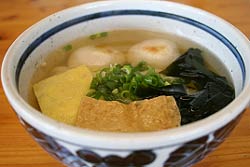
Kazuma Mochi Fukuda, located along Prefectural Road 49, is also famous for its mochi. Toys and rice cakes in the showcase are also popular and sold out one after another. It is said that the shop opens at 6:10 in the morning and arranges products, and the udon shop opens from about XNUMX:XNUMX. There is a unique menu here. First, "Shrimp Okoshi". Rice that cooks domestic shrimp in powder instead of red beans. Shrimp taste and beautiful color are impressive rice. And the other is "An zoni-udon". Sanuki zoni is famous for its white miso-style bean paste, which is made of ordinary dashi noodles with savory roasted bean paste. A gem that can't be beaten by mochi lovers. For those who are not good at Ann, there is "Zoni-udon" with white mochi. Udon and rice cake popular with pilgrims.
Creating taste with hometown
In Yoshioka-cho, close to the Shibata River and close to Mitoyo-shi, there is "Shibao Sangyo Co., Ltd.", famous for pickles that make use of Shikoku ingredients. This building, founded in 1920, has a tasteful building, and it seems that it has relocated the former Kanonji Station. Kannonji's mountain name is called Mount Shippo, and there is the Shippo Mountains in the northeast of the town. The name of the mountain, where the legend that Kobo Daishi buried the seven treasures, is a name that leads to happiness and leads to Lucky XNUMX.
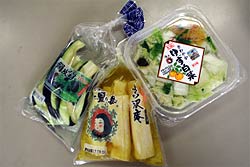
The specialty products include the refreshing apple flavor "Asashinasu", the tamari soy sauce "Tamari cucumber", the plum vinegar flavored "Umezuzawaan", the finest umeboshi "Minamitakaume", and seven types. There is "Shippou-zuke", which is a pickled vegetable, and a popular item in the early fall is a salad made from the silk skin eggplant of the city of water, Saijo City (Ehime Prefecture). Soft silky eggplant. For winter, “Tama Kabura” made from Tokushima-made round kabura is also delighted. And the popular is a pickled gift set named "Ichiyo no Wife". It can also be found in department stores such as Yokohama Mitsukoshi, Hachioji Sogo, Ikebukuro Seibu, and Tamagawa Takashimaya. In fact, the current president's wife is said to be a distant relationship with Kazutoyo Yamauchi's wife, Chiyo. Here, we are actively involved in food education, etc., and form the "Chiyo-no-kai", where you can enjoy delicious pickles and culture.
"I don't care about Sanuki"
By the way, this year's topical sake is Kagawa Prefecture's original sake rice "Sanuki Kimai" which was brought up by Kagawa Prefecture, Kagawa University, Kagawa Prefecture Sake Brewing Cooperative Association and JA Kagawa Prefecture together. This name is a delicious sake made with "good rice" suitable for brewing, and it is said to be named with the meaning of "sickness" of Sanuki dialect, "Please get drunk comfortably." When the first sake is sold in the spring of this year, it is very popular that it is "a fruity drink that goes well with any dish."
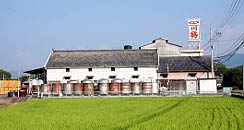
Therefore, we visited Kawazuru Sake Brewery, a brewer who has been making hot drinks with this Sanuki Kimai. Heading out of Kanonji City along Prefectural Road No. 5 (Kannonji Ikeda Line) to the suburbs, you can see a splendid sake brewery that is also designated as a national tangible cultural property along the road. In 24, we began brewing more than 1891 stones of sake. He dreamed of a crane that flew down the Saita River and was named "Kawazuru". The brewers who have been dedicated to sake for 300 years with the spirit of "impressing the drinkers with the honest feeling like the flow of the river" have been stuck to the raw materials, pursuing the skills, and stuck to Sanuki's sake brewing. Was.

The brewers sent out this spring with confidence this spring. Kasumi sake is the first sake squeezed from the original sake that was born in Sanuki Kimai. And, in the summer, "Dragon Drop" is released. In this fall, the last squeezable “Suedreshi” will be released. In addition, the limited sale `` Kotodan Masamune '' associated with Kanonji Treasure at Kanonji is not only tasted good, but also labels and bottles are reviving the brand at the time of its establishment, so it is attracting attention from all over the country that you want to get it by all means It has been.
Here, there is a museum (open only on weekdays), which is a renovation of a former rice brewery, and you can also see old sake brewing tools. The Yuzurukan Gallery Serabi (open from 1st to 5th every month, January 1th) displays and sells handmade miscellaneous goods and antiques by artists from the prefecture.
Kanonji town walk ticket
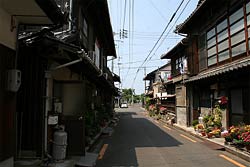
There are courses around eating and walking around Kannonji. Course A buys a 500 yen ticket and walks around the designated shops. Each store has regular holidays and business hours, so check them out. Course B requires a reservation and the ticket fee is 1000 yen. The apron guide who the aunts work for will guide you through the town. Of course, delicious shops. Tickets are available at the World Coin Museum, Taishobashi Plaza (Ekimae Tourist Information Center), and Kannonji City Commerce and Industry Tourism Division.
















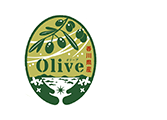 Olive products from Kagawa Prefecture
Olive products from Kagawa Prefecture

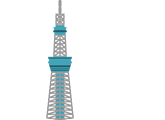

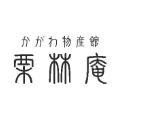
 Stores handling olive-related products
Stores handling olive-related products
